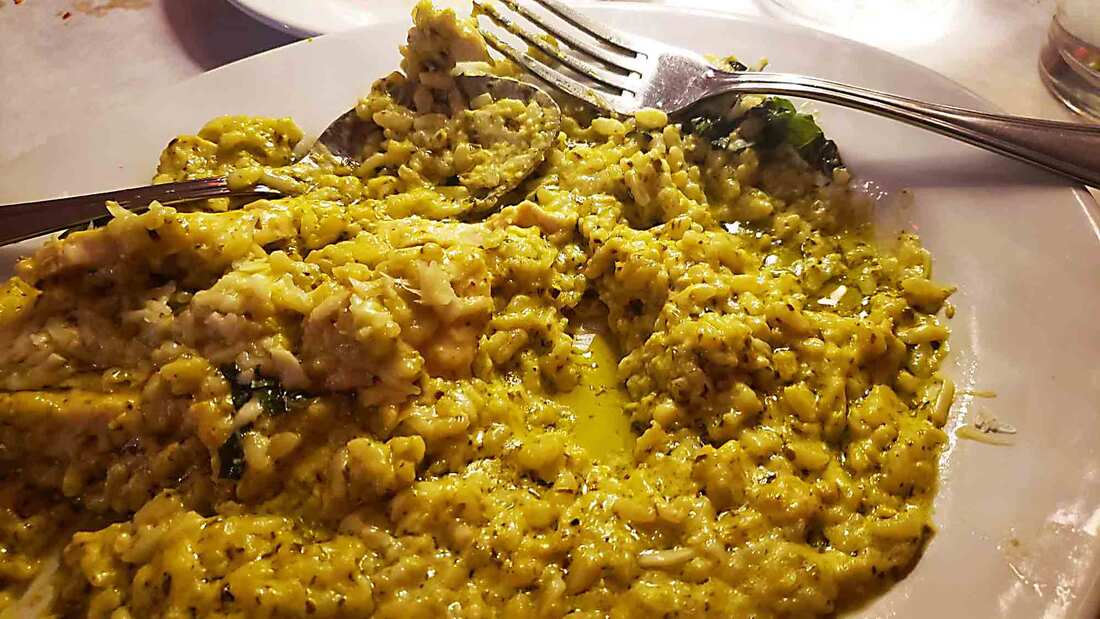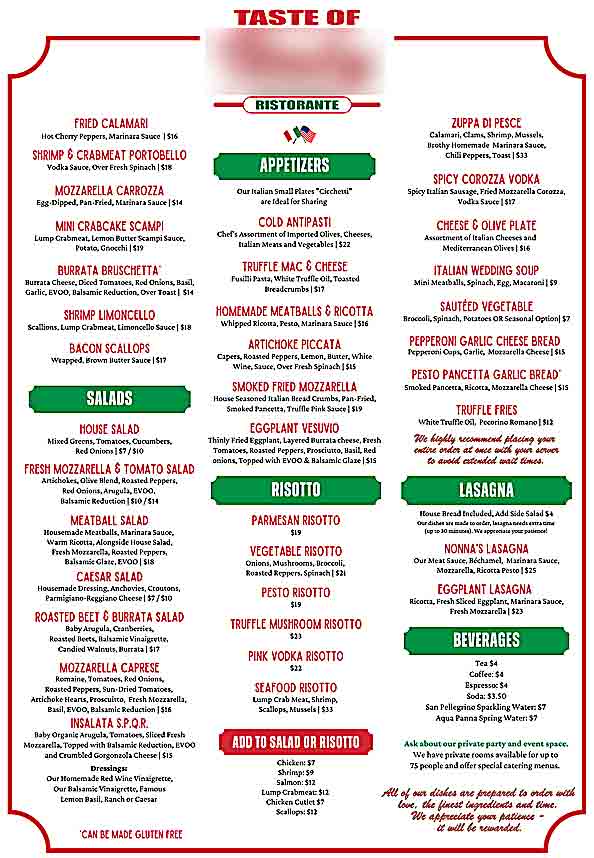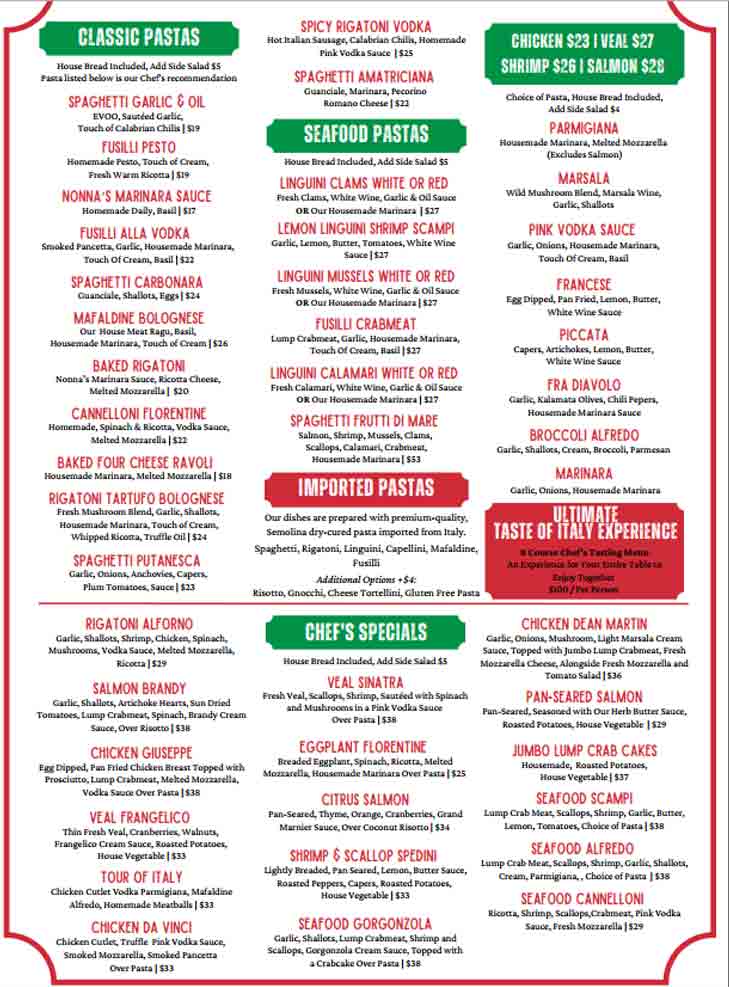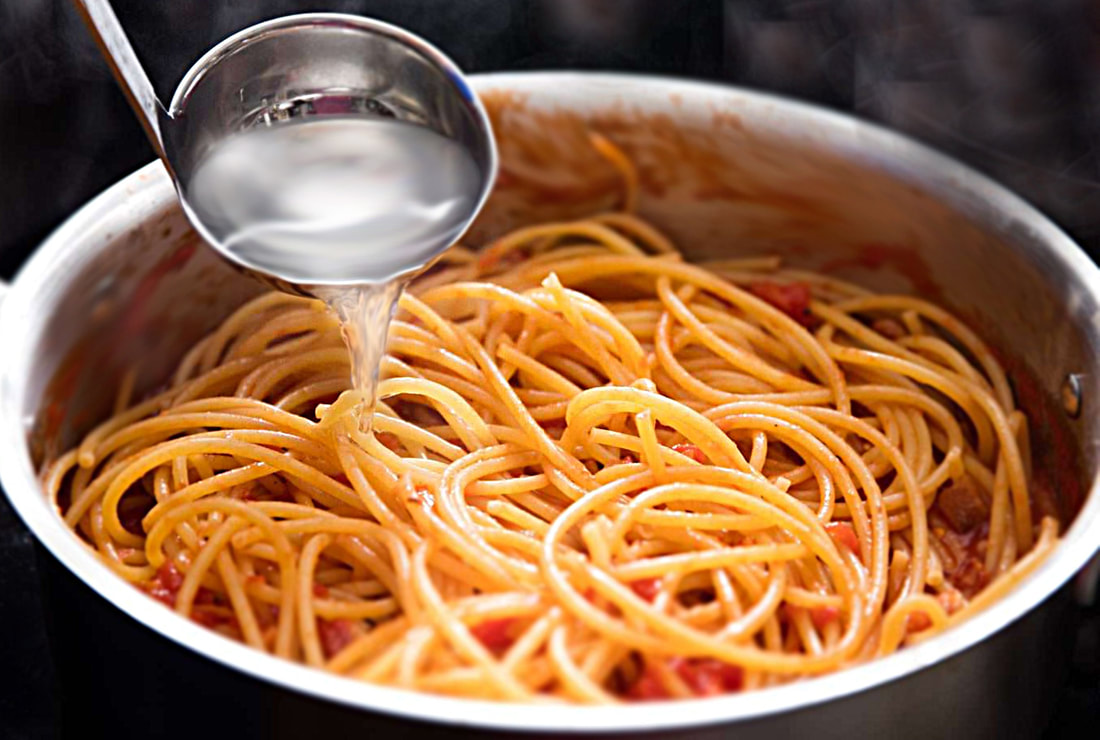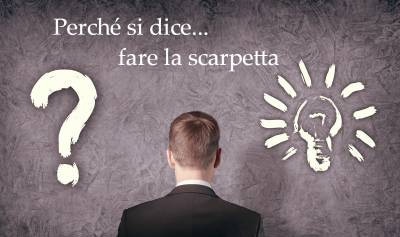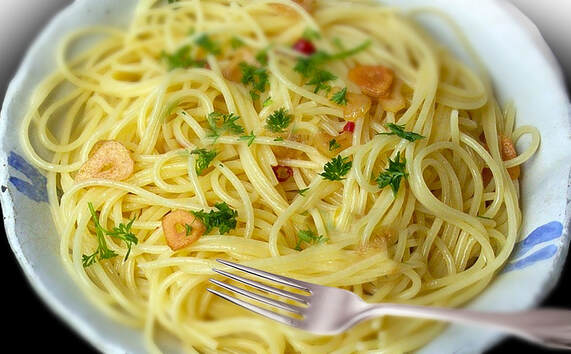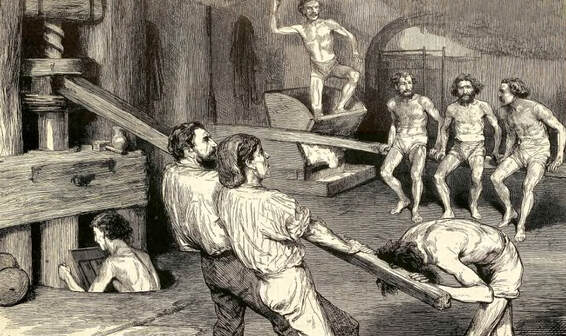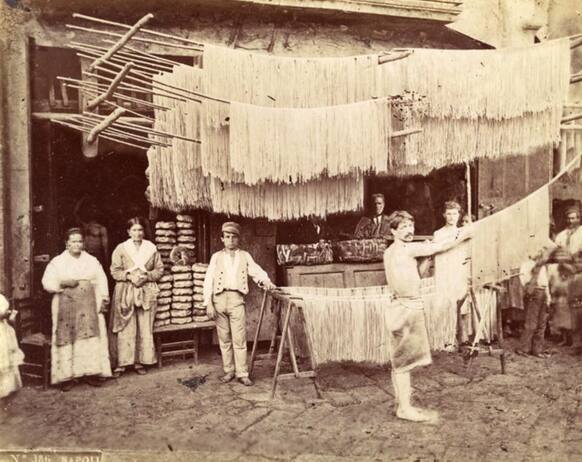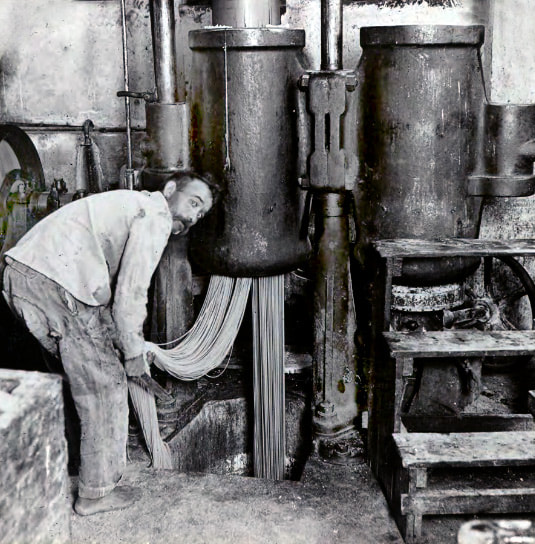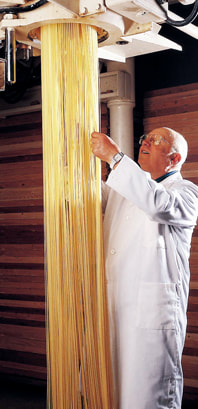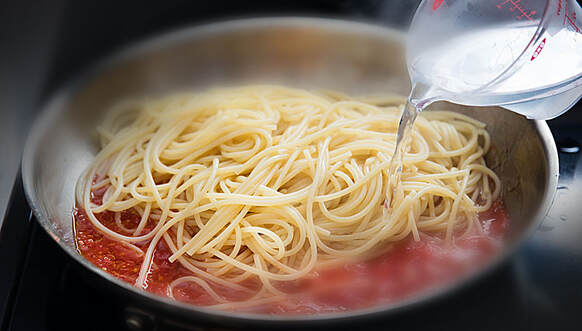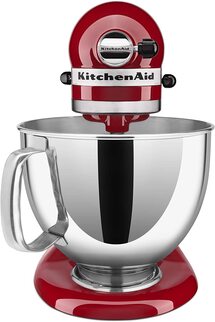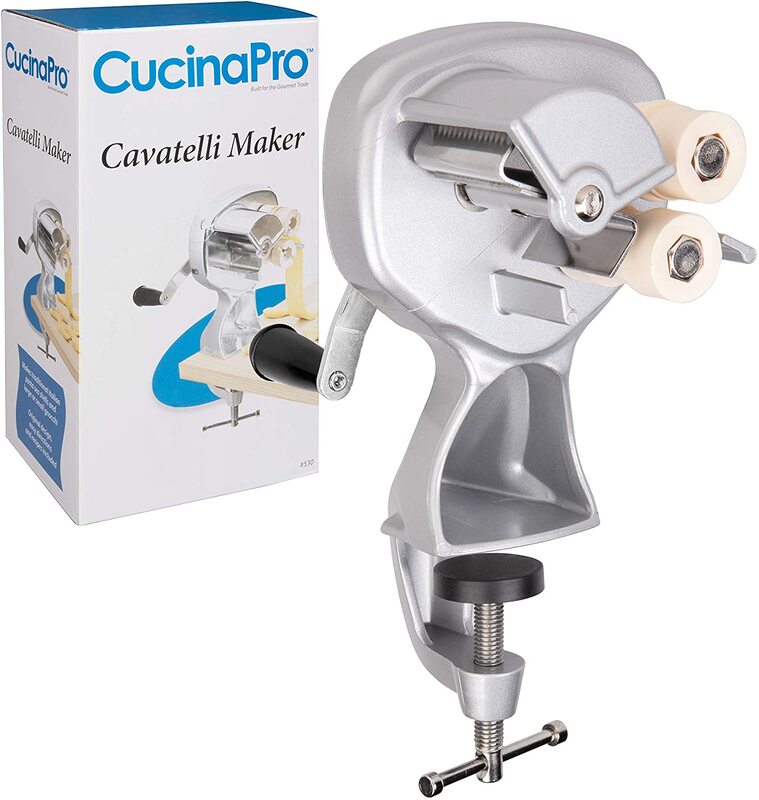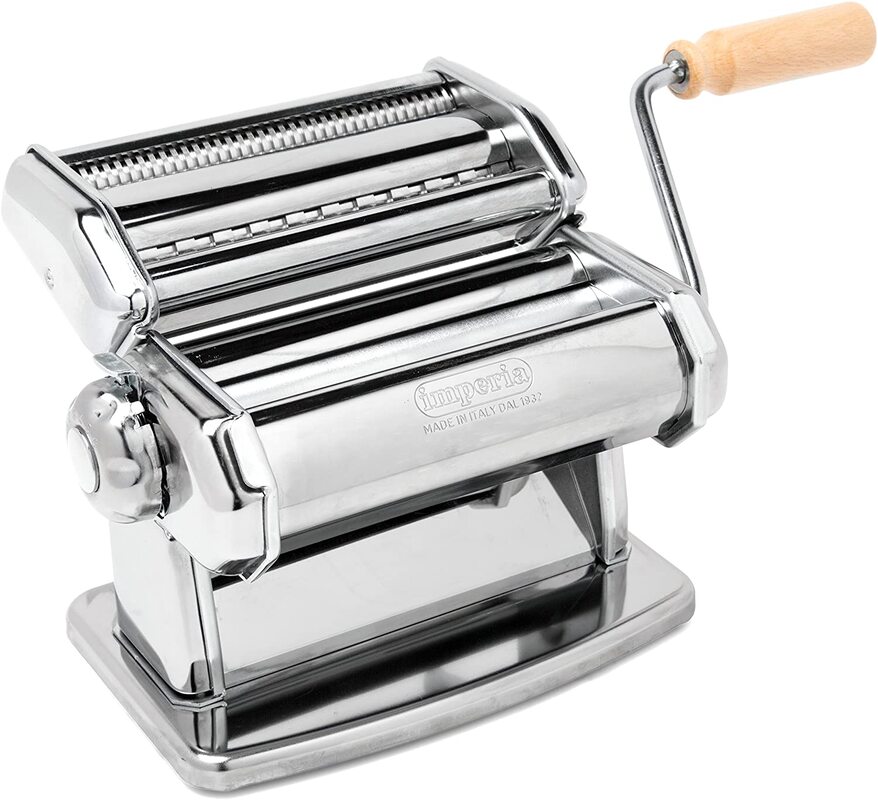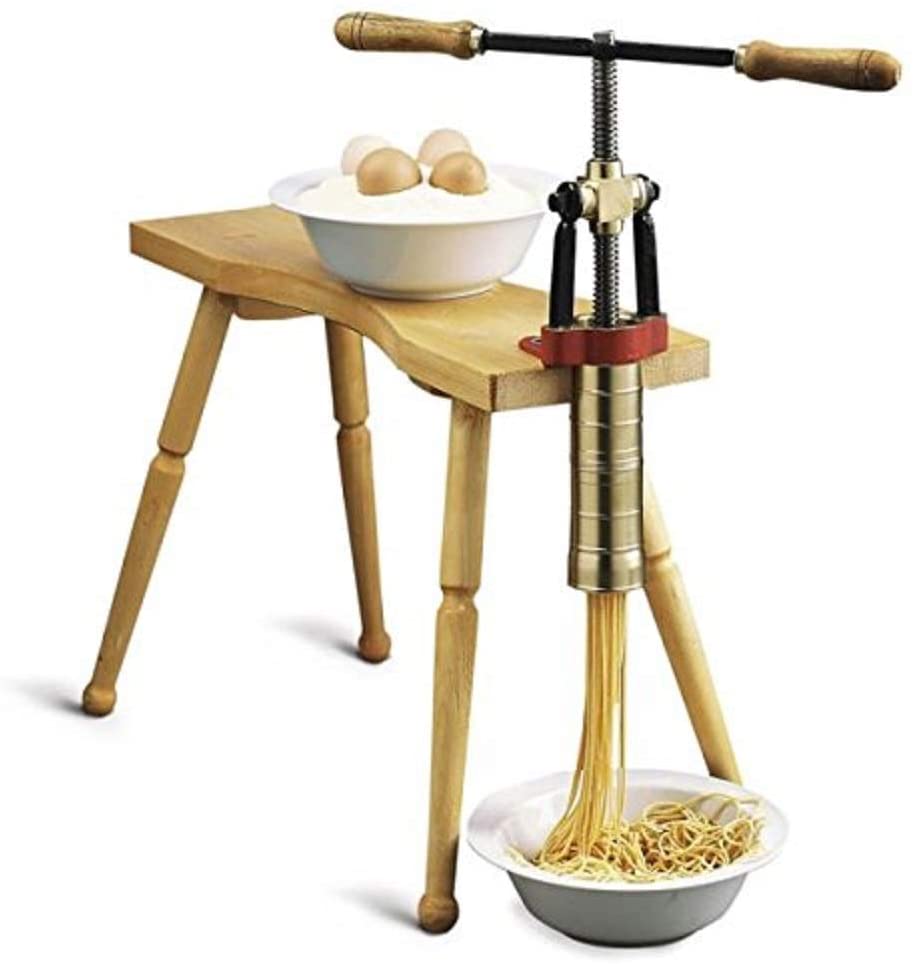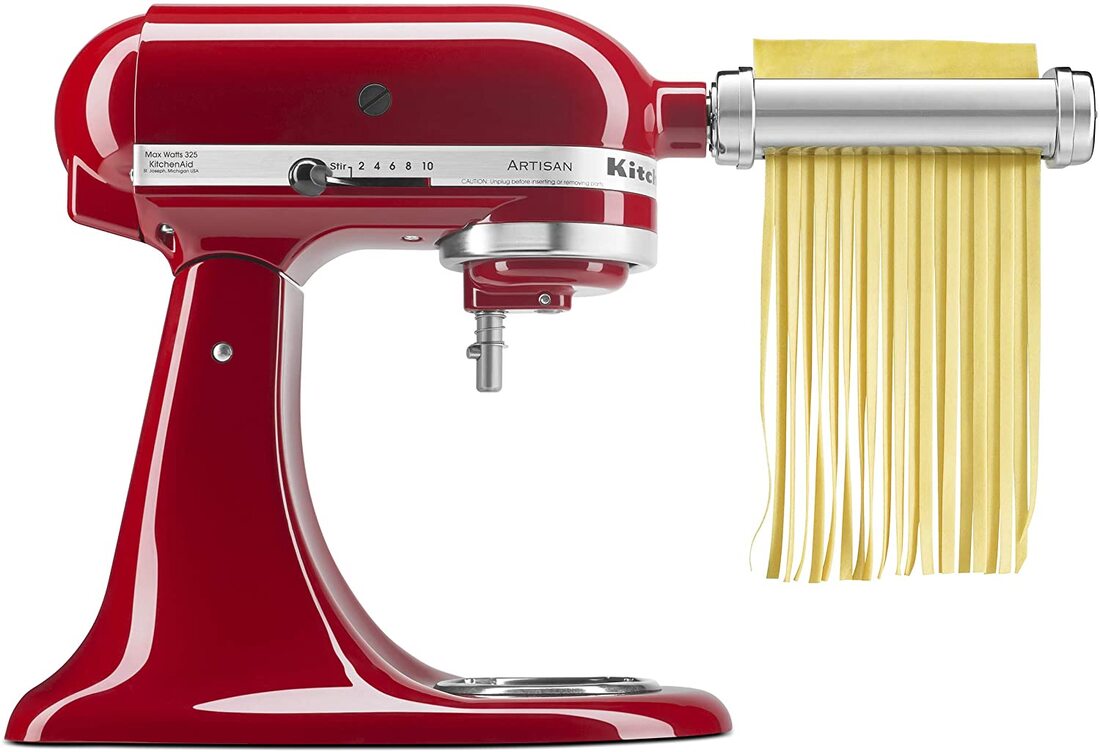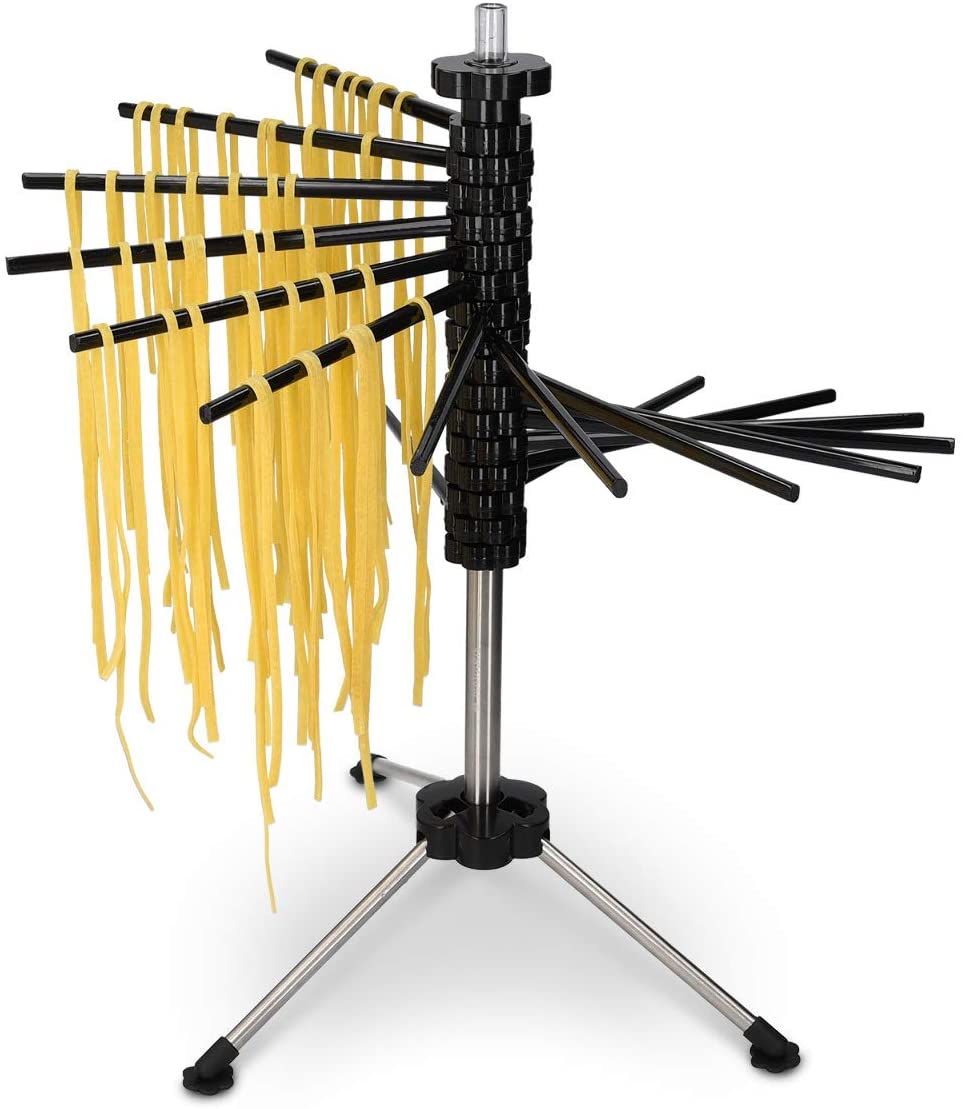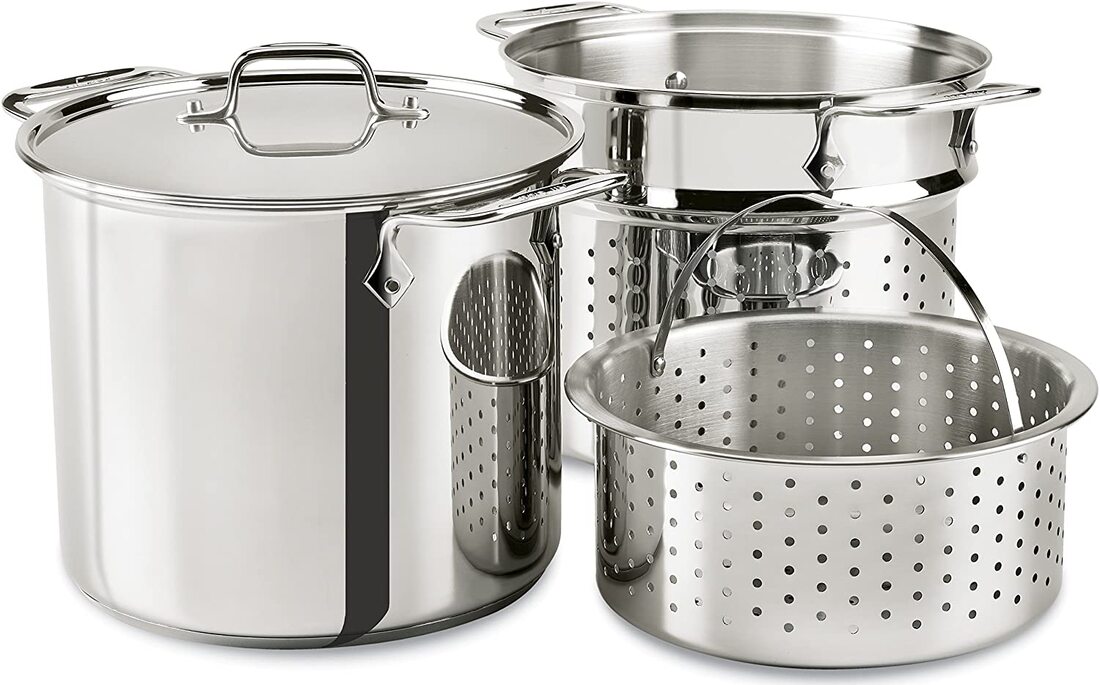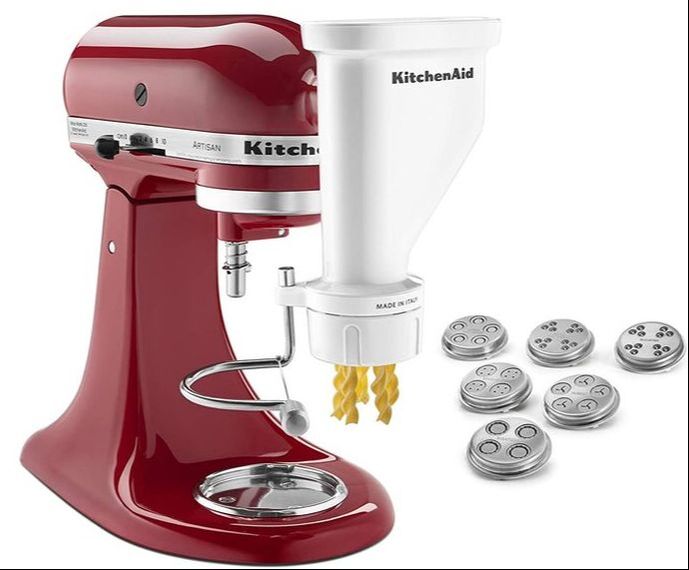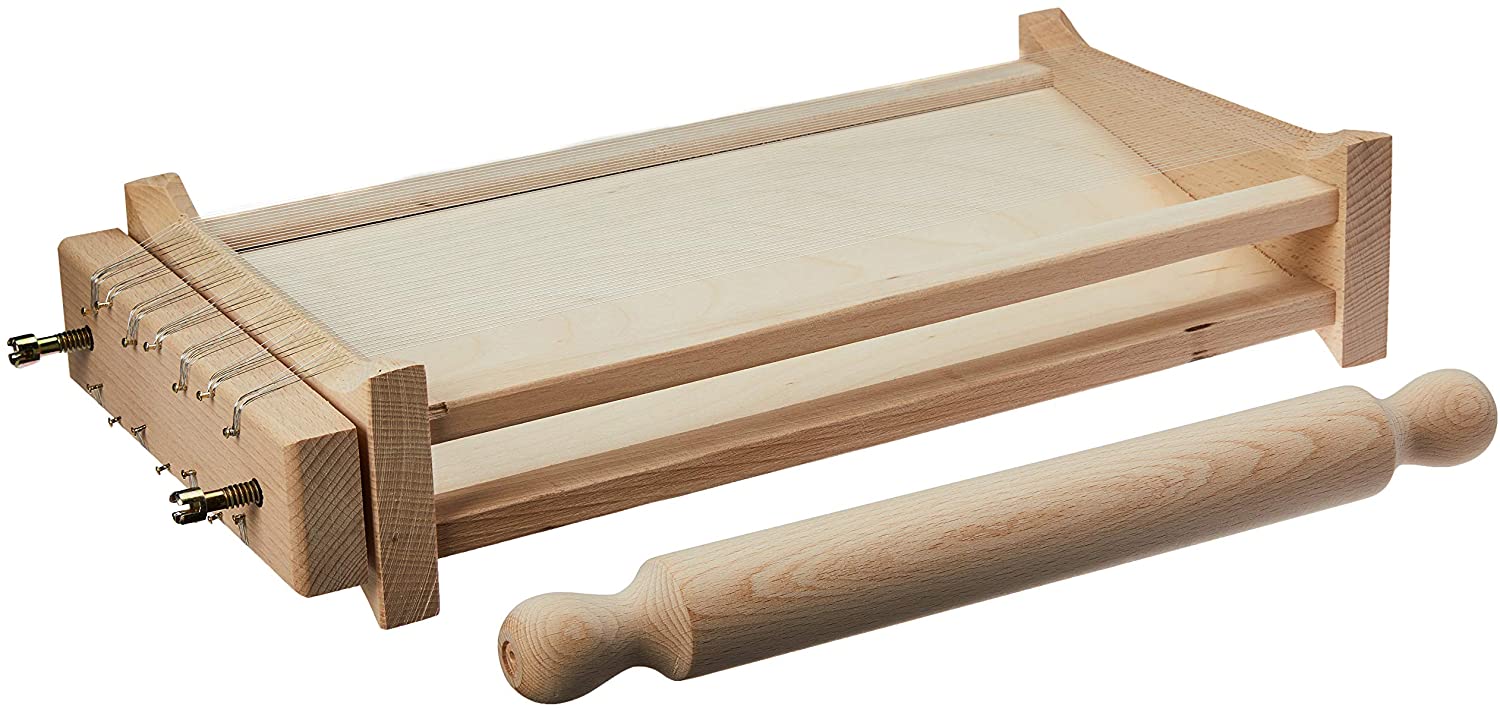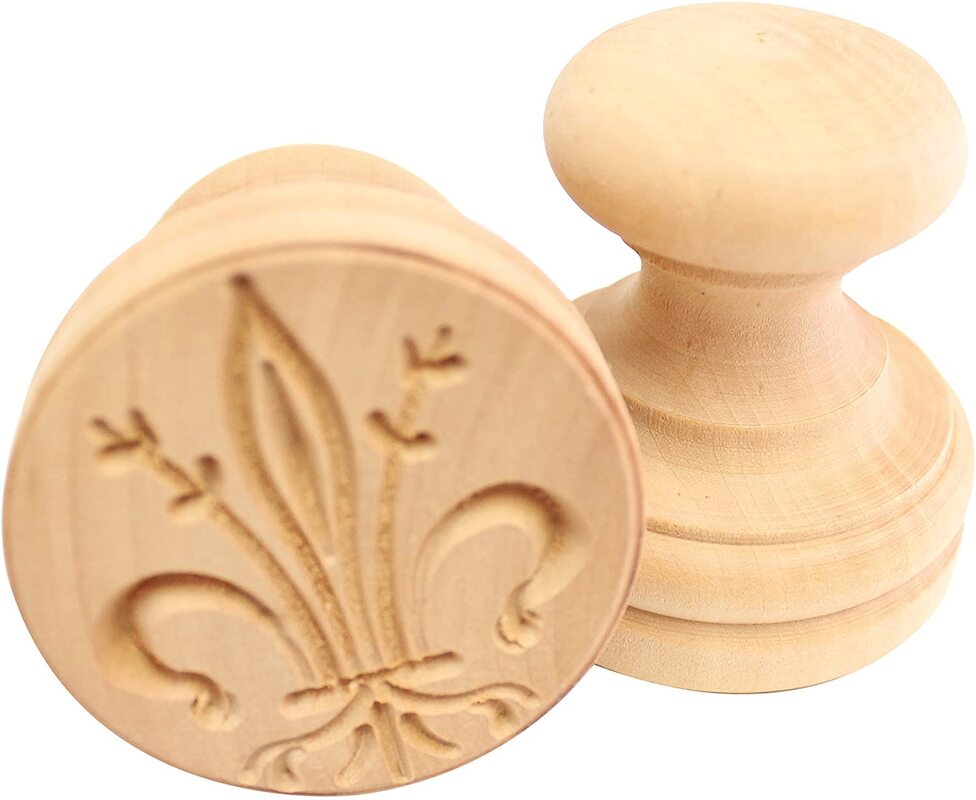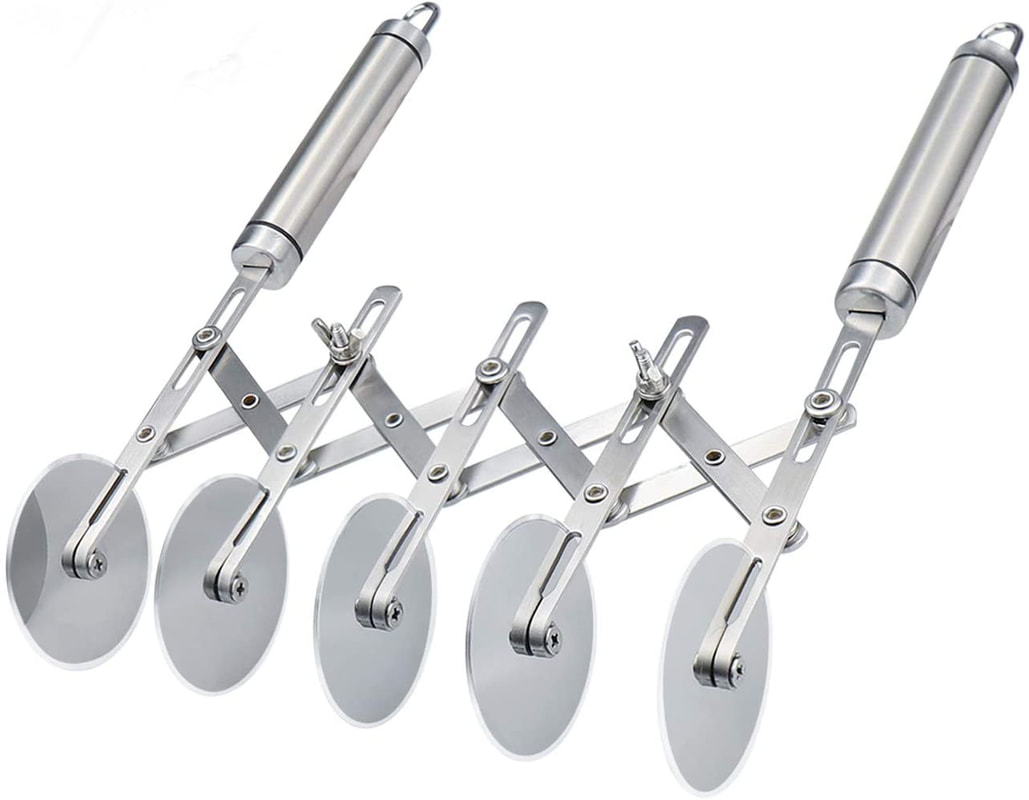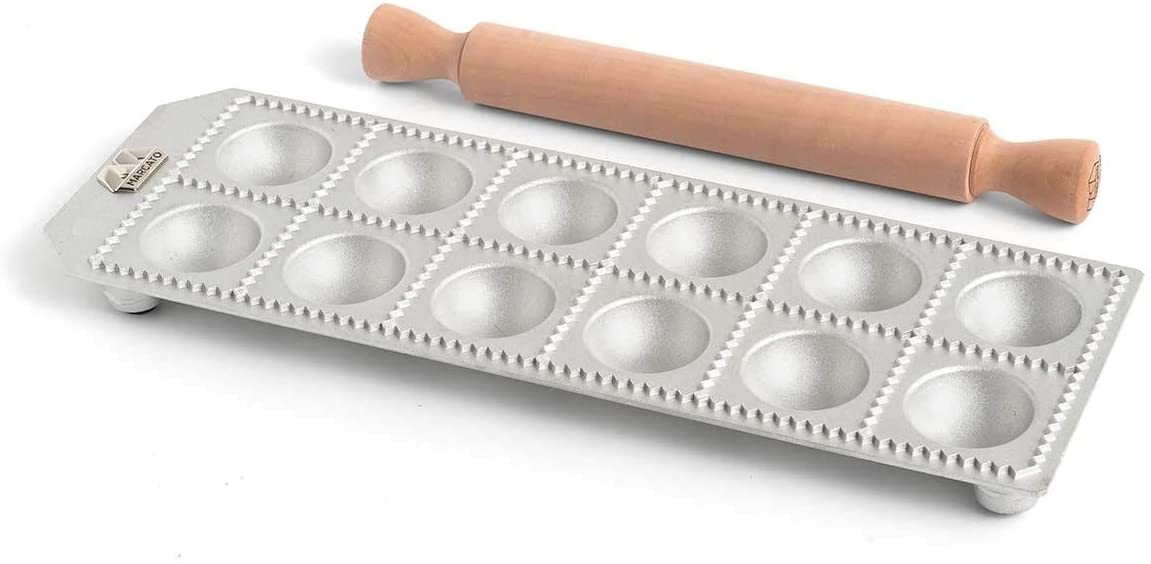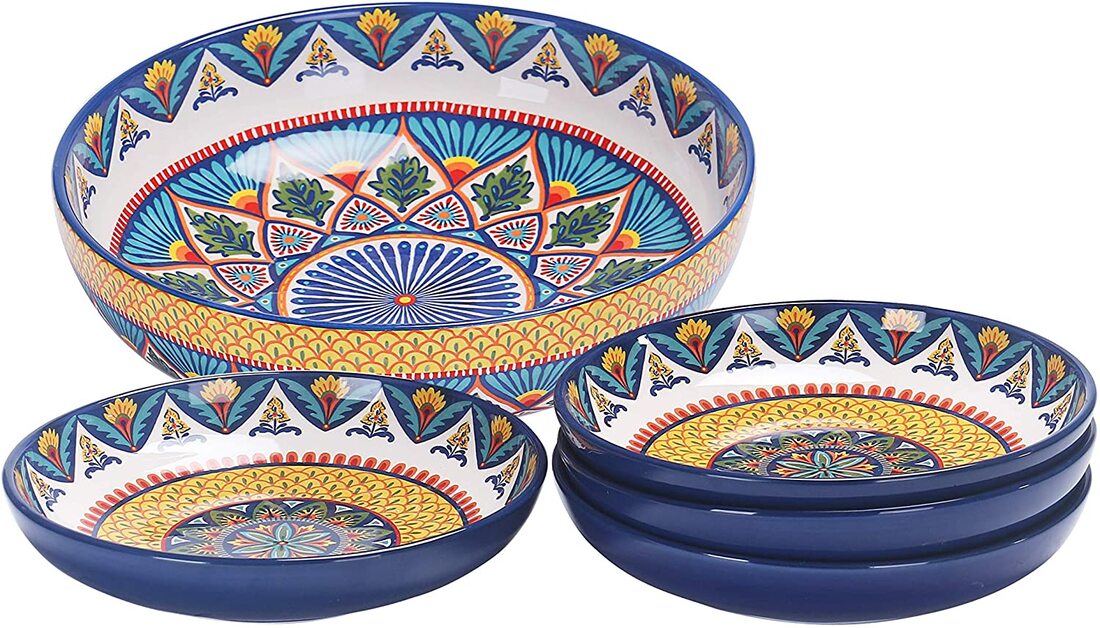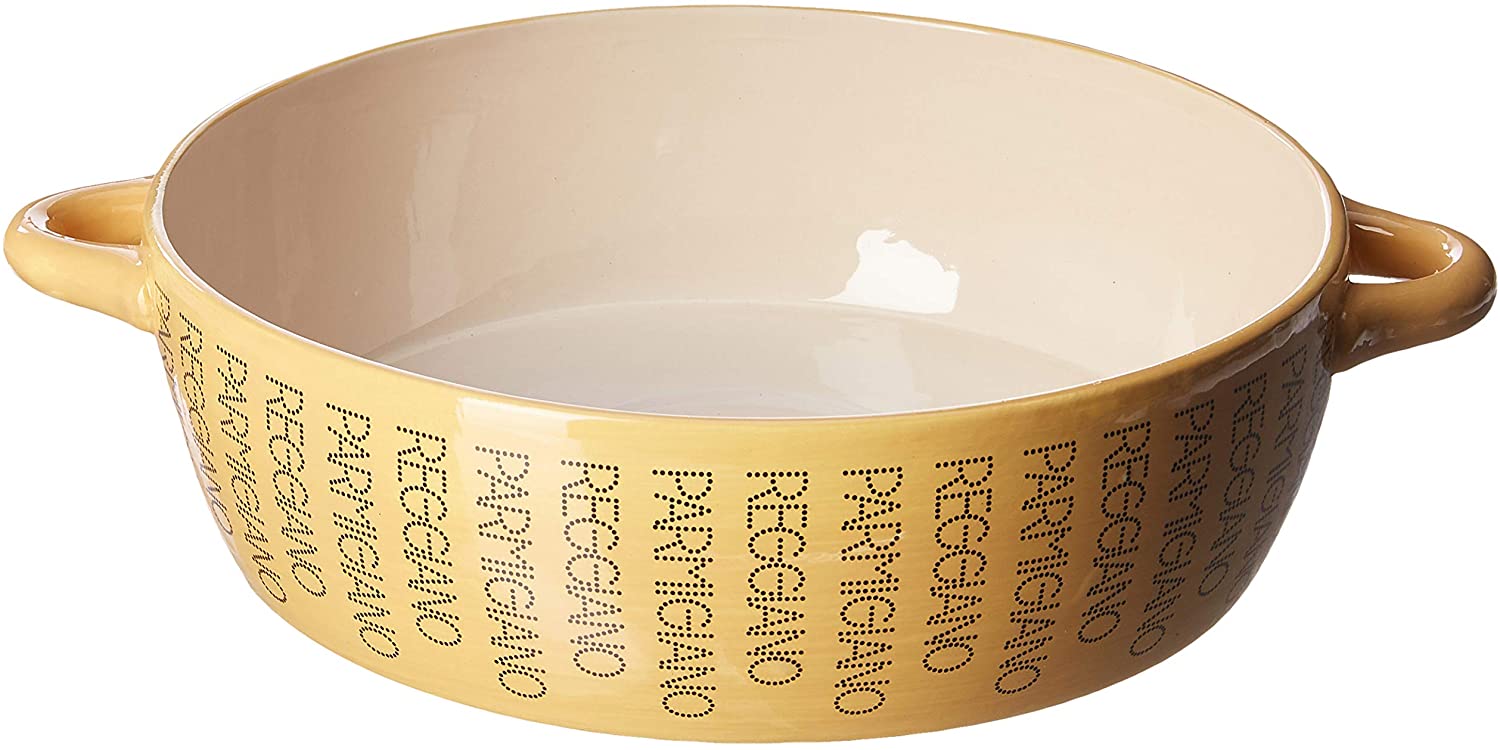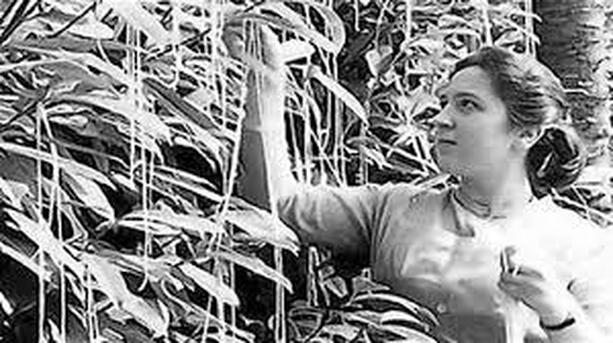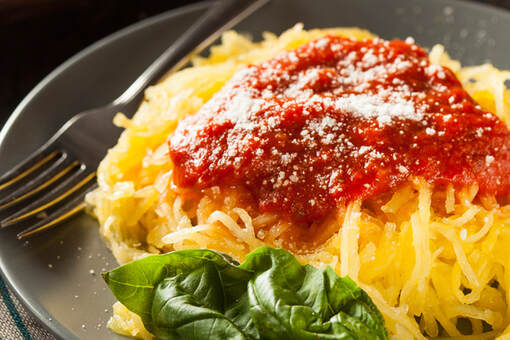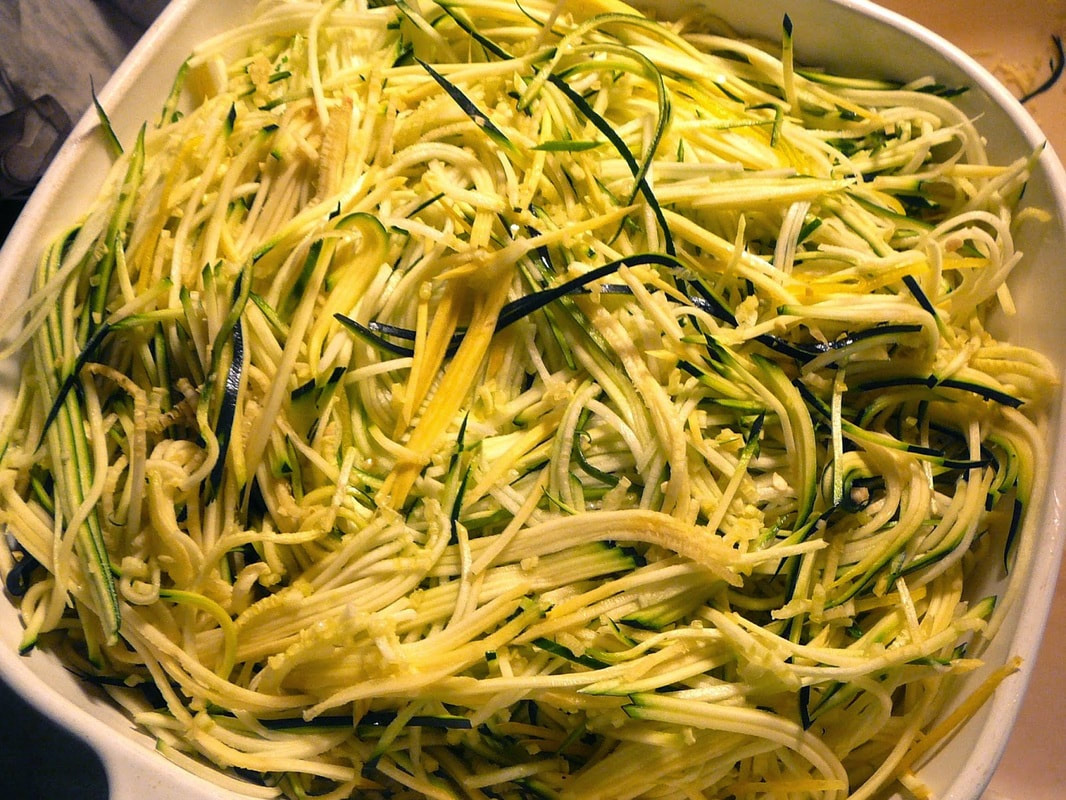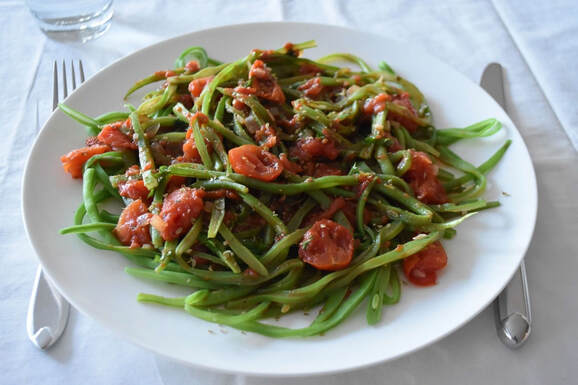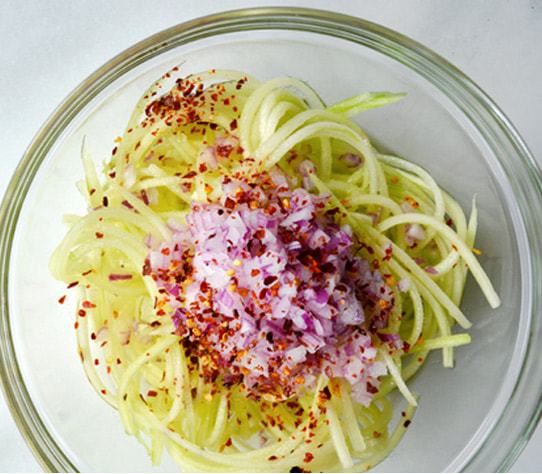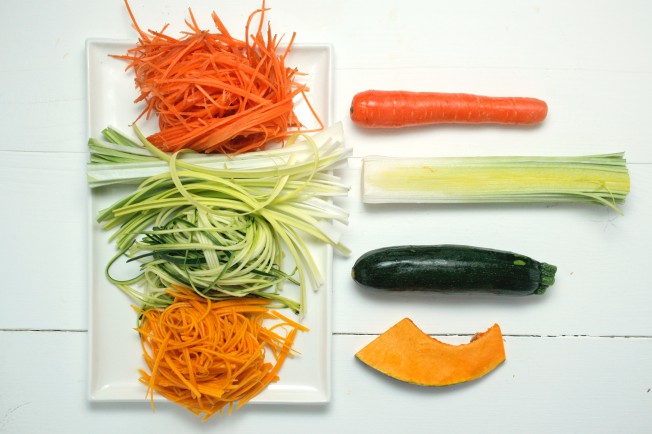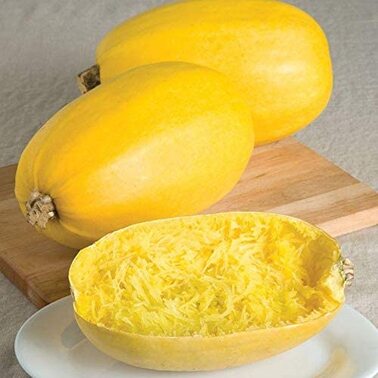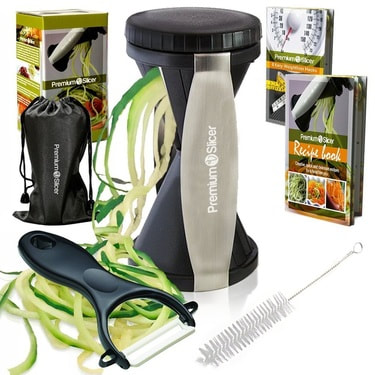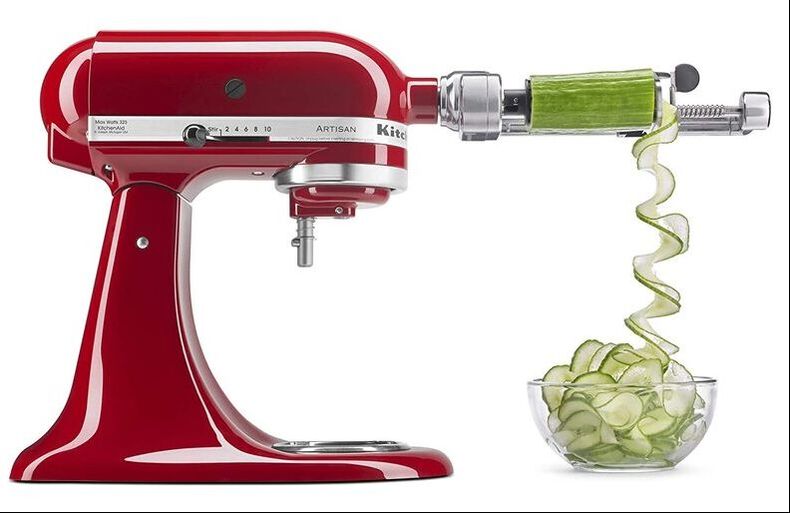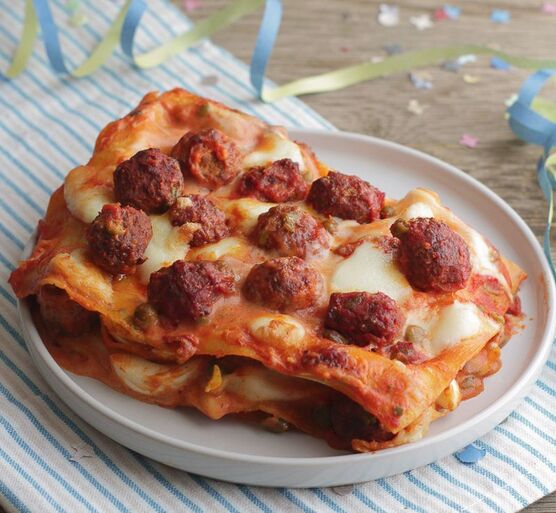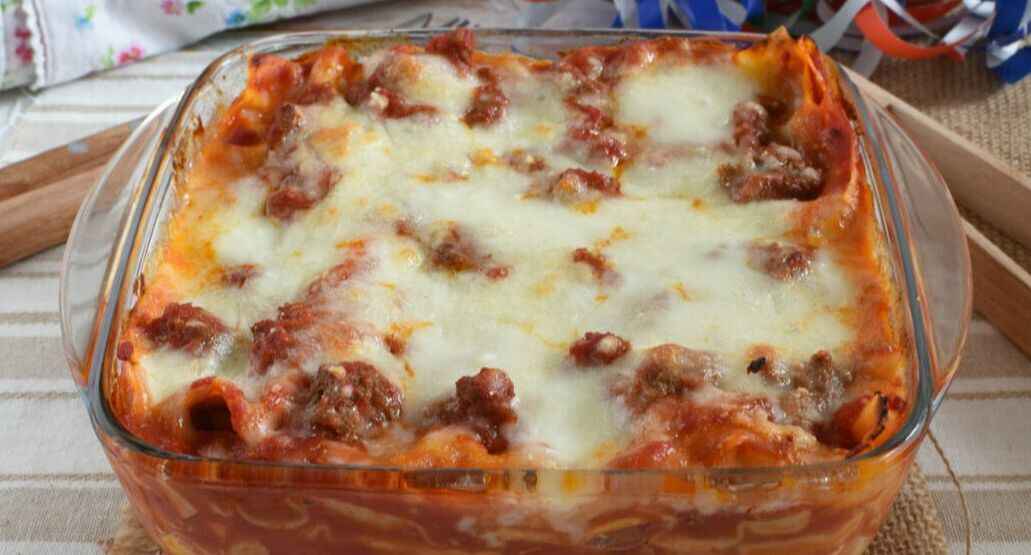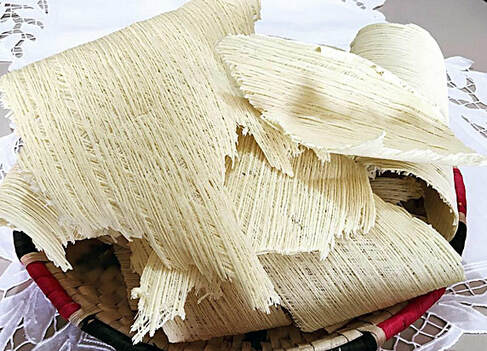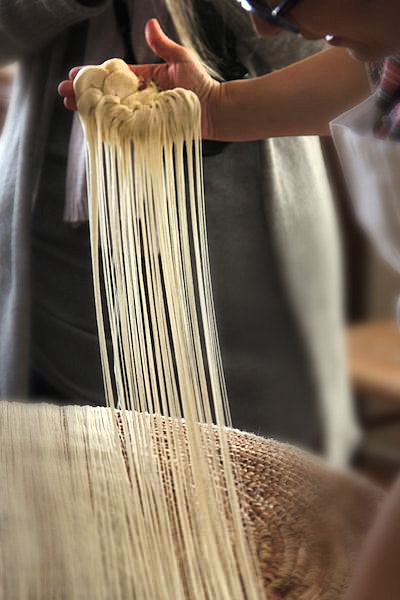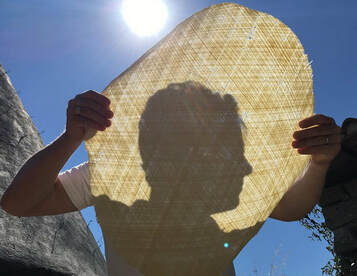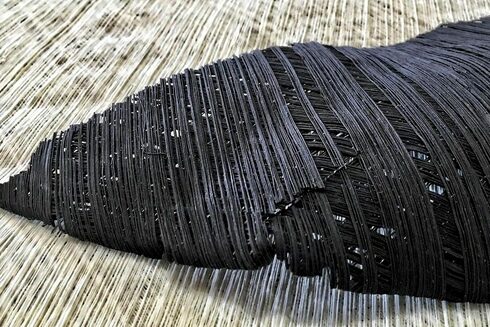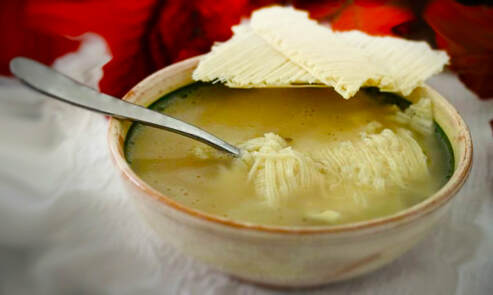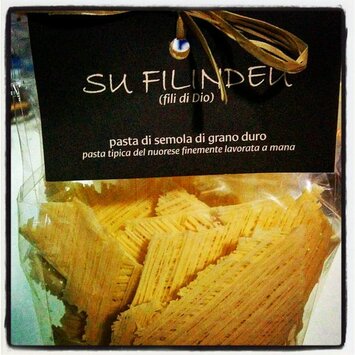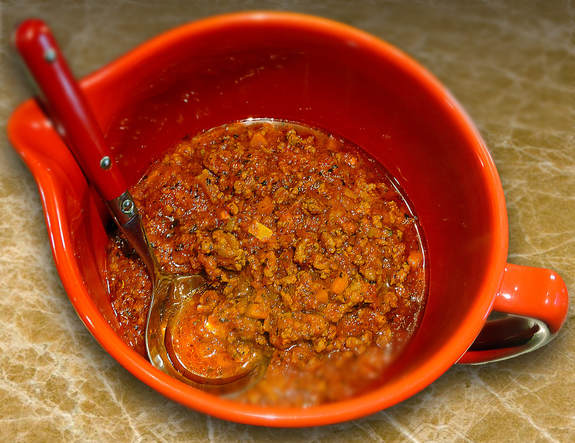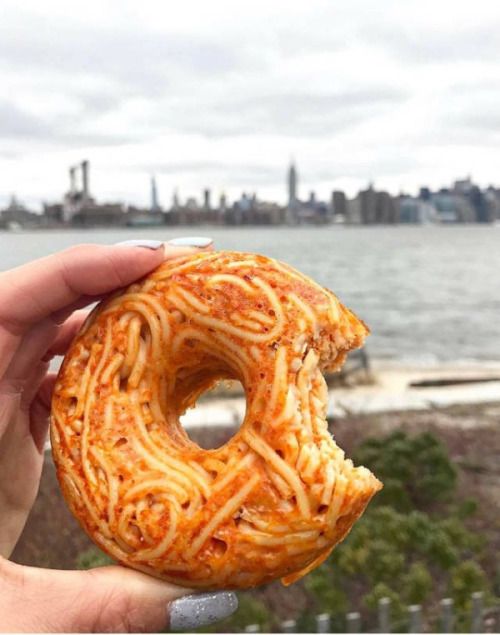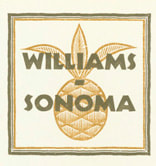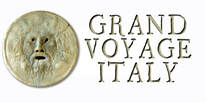|
This is it. I'm at my wits end. Is eating out at so called "Italian" restaurants worth the high prices, poorly prepared, unauthentic and inconsistent menu choices? This past Good Friday evening, my wife, son, his wonderful girlfriend and I went to a "Italian" restaurant called Taste of _____ in a nearby town. (Fill in the blank. It's one of the most overused names for Italian restaurants and pizzerias in the U.S.) The place has been getting mostly great reviews on social media from locals (Italian-Americans are a minority around here), so my wife made reservations and then... At first, we were confronted with a strong fishy smell as we entered the place (i.e, not fresh). The menu: a very typical Italian-American, overpriced (for what we received) menu with pizza place graphics. There were dishes named after Sinatra and Dean Martin and oddly one named Da Vinci. There was a volcano pile of stuff called Vesuvio and a "meatball salad"--meatballs "alongside" a salad.(Most reviews claimed the meatballs were terrible, so we didn't dare). The antipasti mix had tightly rolled, cheap capicola and a tasteless prosciutto with green and black olives straight out of a plastic 5 gallon restaurant jug. We also ordered a "fried mozzarella" that turned out to be a grilled cheese with mozzarella. The menu was missing any Neapolitan pizza, fresh pasta dishes, bistecca, boar stew or even fried/stuffed olives, chickpea fritters or arancini. Some pasta dishes were not finished in the pan, with sauces placed on top. Many were heavily finished with olive oil. The bread in the basket was not great and there was a large slice of butter swimming in a bitter, low grade olive oil mix for dipping (I suppose). There were no Primi or Secondi dishes. Proteins were mixed in with pasta on the same plate--Italian-American style. As for presentation, the portions were HUGE with so many things thrown on top, creating visual chaos. (Looking like a regurgitated meal). The finisher in the kitchen surely had a heavy hand with many dishes swimming in olive oil. (Many photos on their Google page was evidence of this). There were dry pasta dishes with Bolognese sauce (what, no fresh egg pasta?) and other misidentified pasta shapes. There was an extreme overuse of garlic in some dishes, as my son's girlfriend had in her mushroom risotto. Native Italians use garlic only to flavor the oil at the beginning, then remove the cloves. My wife said she had to "saw" through her overcooked chicken cutlet and her gnocchi were definitely made from frozen and were gluey. 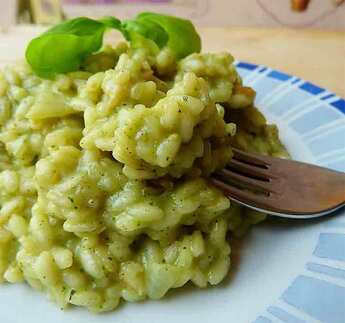 This is how I expect a pesto risotto to be This is how I expect a pesto risotto to be At the top of this post is a photo that I took of my "pesto risotto" at the end of our meal... about 45-55 minutes after arriving at the table. You can clearly see the pools of oily fat (olive oil and broken sauce). Responding to my local review, the "owner/chef" claimed I finished 60% of the dish--I actually left 80% or more of this HUGE portion (enough to feed 3-4 people). Also, I want you to note the huge spoon they placed on the plate, the same many American restaurants use, expecting diners to twirl spaghetti with. Five minutes into the meal my stomach was feeling queasy. There was a broken, heavy sauce (cream added?) and it looked like they poured olive oil over the risotto, pooling below. Perhaps they added too much butter and cream to finish over heat and the sauce broke. The risotto was not made with carnaroli or arborio rice. When making risotto, this type of rice itself produces its own starchy "cream" and causes l'onda (a wave). This was a gloppy mess. I still felt nauseous 2 hours after. None of us were satisfied with our meals. My son's pesto pasta had very little actual pesto with olive oil pooling underneath. Instead of a classic dollop of pesto on top, there was ricotta (not mentioned on the menu). He felt thee pesto was made using dried basil with only a blackened chiffonade of "fresh" basil sprinkled on top. I concurred. My dish sat in from of me for about 45 minutes while I picked away at it during our diner chat. Uncharacteristically, I didn't want to complain on Good Friday and while we were getting to know Lucas' girlfriend. The waitress came over once to ask how everything was, and my wife answered "fine" while I bit my tongue. After asking for the check, someone asked if I was finished, reaching for my plate just as I was pointing my phone at my dish--something that many do nowadays. Seeing me take the photo, they walked away and went right up to the owner, as my wife witnessed. During this evening, the owner stopped at nearly every table except ours... mostly filled with his "regulars". As we've noticed before in our area of Eastern Pennsylvania, most locals have no idea what a good Italian dish is. Our running family joke is about a German restaurant that is "famous" for its "incredible" pizza--flat, tasteless pizzas made and frozen before reheating! You know when the place that sells "pizza" also has Philly cheesesteak sandwiches on the menu, the pizza can't be good. Responding to my local review, the owner said he "knew these people would be trouble" as soon as we sat down, and that we just wanted a free meal. He also claimed that I pulled the plate out of the waitresses hand to take the photo, with my "agenda" to give a bad review. Never happened. The waitress (passive aggressively) did come back and asked why I took a picture and why I didn't want a "doggie bag". I then told her how dissatisfied I was and how the sauce was broke and oily. I didn't want to take the rest of the dish home. She offered to fix it, ridiculous as the bill was being paid and considering their lacking technique for preparing any classic risotto dish. She apologized and I said it was not her fault, and reminded her, "YOU aren't the chef". I never asked to comp my meal, but even after my complaint, the full charge was still on the bill when it arrived. Most places comp without even asking for it. I paid the full bill and a 20% tip and we left. We only drank water, had no desire to have desserts after our poor meals, and were billed over $150 for the privilege of eating at this phony Italian "ristorante" with busboys wearing Godfather T-shirts and Vic Damone and SInatra music pumping out of their speakers. Responding dozens of times to our local review, and literally dozens of locals defending this inauthentic place's food, the owner made himself look bad by his ridiculous and insulting accusations. There were also scores of people agreeing with my review and saying how the owner's nasty arrogance and lack of customer relations tact was hurting his own reputation. It was a typical social media flaming event. Shocking, really. All I did was post an honest review. His belligerence toward a simple, truthful diner's own experience is utterly out of place for someone wanting to make clientele happy. This owner's attitude is going to repel clients... look at other restaurant owners who offer condolence and ways to make them come back until they are served a satisfying meal. There is a New Jersey pizzeria that we order take-out from occasionally that gave me a rubbery chicken dish once. No questions asked, they offered a gift certificate as compensation. This is after all a hospitality business. Lisa is usually the one that wants to try the new places getting lots of social media buzz. I think after this, even she wants to call it quits. Our biggest complaint--even when we find a place with good food--is lack of consistency. The next time we return, we never are as satisfied as the first time. Bottom line: We've been saying this for years now... "Why waste big dollars on meals that we can cook better in our own kitchen?" Besides, we are nearing the end of our new kitchen renovation... We can't wait to have an oven again and cook on our new 36" gas cooktop with grill! Share your experiences from recent years at restaurants that others think are great. Are you disappointed too? Please leave a comment below. Ciao for now, --Jerry Finzi Without a doubt, one of the best ways to discover truly authentic Italian recipes is to subscribe to Pasta Grammar's YouTube channel. Follow them on social media too... @PastaGrammer. You see, aside from the nonnas on the Pasta Grannies YouTube channel, this raven haired Calabrese, Eva is one of the best cooks who uses traditional techniques for traditional Italian dishes. Her recipe for ciabatta is one you'll want to make every week. --Jerry Finzi One of the primary philosophies of GVI is passing along ways to live a more Italian life (even if you're not in Italy), often shedding and evolving away from the often corrupted and devolved Italian-American traditions and methods of language, culture, and of course cooking. One of my biggest changes in recent years is to my old Italian-American method of cooking pasta--simply topping with sauce. I learned from my mother. She would boil and drain the pasta, then pour sauce over the top of each individual plate of pasta, leaving it up to us whether or not to toss with the pasta or not.
The authentic, Italian method of cooking pasta is under-cooking the pasta, then finishing in the saute pan where you have prepared the sauce while the pasta is boiling. The next step is adding the under-cooked pasta to the saute pan, then adding a few ladles of starchy pasta water. Cooking further and tossing the pasta, the starch in the water allows the sauce to thicken and cling to the pasta. The pasta water both cooks the pasta and thickens the sauce, until the sauce becomes creamy and coats the pasta in a shimmering way. This method impregnates the sauce INTO the pasta and imparts enormous flavor. In Nostra Cucina, gone are the days of putting drained pasta on the plate and simply topping with sauce. Buon Appetito! --Jerry Finzi 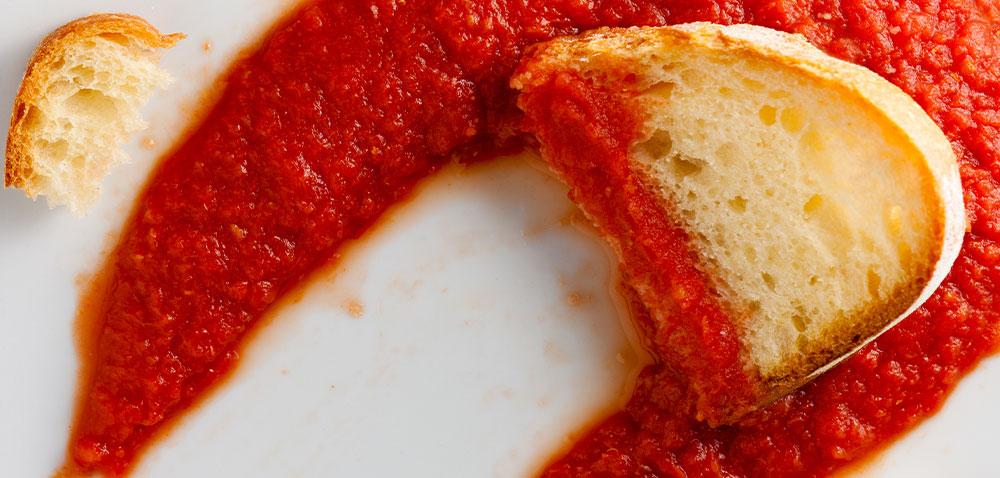 When I was a boy, we always had bread in our home. My Dad worked as a Deli man most of his life and would bring home beautiful Italian breads that he used to make cold cut and meatball sandwiches. In typical 1950s style, my Mom would keep loaves of white bread in what she called her "All-American house". When we had pasta with "gravy", we'd tear off some bread to use at the end of the meal to clean up the plate. Even when we had meat, like a roast beef, the bread would come out and we'd soak up "the blood" (the drippings) that oozed out of the meat in the bottom of the serving platter. If we had soup or a stew, the bread would work its way to the end of a meal to clean our plates. And if my Mom was making Sunday Gravy, we'd get out the bread, even if all we had was sliced Wonder Bread (ugh), and smear a ladleful of sauce on a slice for a pre-meal snack. 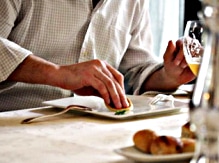 Why scarpetta (little shoe)? Wouldn't it be better to call it scopa (mop)? Little did I know what we were doing was carrying on an Italian tradition in dining--fare la scarpetta (making the slipper/shoe). Scarpetta means shoe in Italian. And to fare la scarpetta a tavola, means tearing off a piece of bread at the table to mop up the sauce or juices left on your plate, help in getting your food onto the fork or spoon. In my father's poor childhood--growing up in a Hoboken tenement with a large family--there weren't enough forks or spoons to go around, so using bread as a scarpetta was a necessity to lift bites of food out of the large communal bowl my grandmother would place in the middle of their table. Nothing goes to waste in Italy, and especially in the impoverished South where my parents came from, one would never leave anything on their plate. Food was life itself. After all, not wasting food is being furbo. And in the South, they don't shy way from having bread with pasta, like they do in the North. What is the preferred type of bread for use as a scarpetta? Curiously, it is ciabatta, which literally means slipper, but any crusty bread will do. Some say that the expression scarpetta comes from the fact that a torn piece of bread looks like a little shoe. I prefer to think that it really refers to wiping your feet... as wiping the bottom of the plate. Because of the extreme poverty suffered by many of our Southern Italian ancestors, others think scarpetta refers to being so hungry that one would eat the soles of their shoes. Sadly, there is historic evidence of desperate people doing just that, so perhaps there is some truth here. 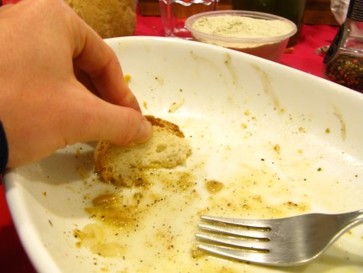 Scarpetta can work with the right OR left hand Scarpetta can work with the right OR left hand However, the tradition of using bread to clean up plates goes back to the time of the Romans. I remember reading in my Latin study book how Romans would use bread after a meal to clean their hands--soaking up the juices and olive oil on their hands--and also cleaning the bowls and the table. They would then pop the soppy bread into their mouths. Again, furbo... nothing is wasted. Fare la scarpetta is an ancient tradition indeed. Perhaps because of its links to Southern culture and Cucina Povera, some areas of Italy consider using a scarpetta bad taste, even though its taste is actually pretty good. Most do it at home or in more casual trattoria and less in more chic ristoranti. But they all do it. And if someone tells you that they don't do it in Tuscany... nonsense. In fact, it's one of the only ways to add flavor to their saltless Tuscan bread. (That stuff is so dry on your palette without salt!) You'd be well served to consider Tuscan bread more of an eating tool, like a spoon or fork, than a bread for eating by itself. You can also do what many Italians do and consider the philosophical meaning of the phrase, fare la scarpetta: Live life fully. Never leave crumbs behind. Soak up everything that life puts in front of you. --Jerry Finzi The History of Pasta
Interesting Pasta Facts
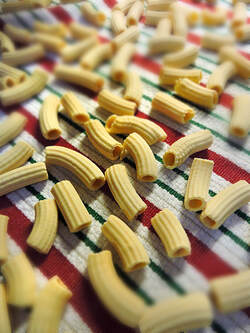 Cooking and Making Pasta
--Jerry Finzi Useful Pasta Tools on Amazon You might also be interested in...
Map of Italian Regional Pastas Corzetti: A Regional Pasta that Really Leaves an Impression Sugo: The "Sunday Gravy" of my Childhood Discover Pallottine from Abruzzo The Light Way to Make Potato Gnocchi The Rarest Pasta in the World - Threads of GodTorta Rigatoni Piede Bolognese al Forno - Baked Standing Rigatoni Pie with Bolognese I'm not a gullible man. Even as a boy, I wasn't one to believe everything I was told. I always asked questions... "Why? Where? When? How?" I read lots of books, including my entire encyclopedia set and my Atlas. I loved science and the arts. I used both sides of my brain. But as a 12-year-old watching the old Jack Parr show in 1963, I tended to to go by the old adage, "Seeing is believing"--especially if you see it on TV! Big mistake! What I saw was a very legitimate sounding short documentary film with a very scholarly, British voice talking about the spaghetti harvest in Switzerland, and mentioning the "tremendous scale of the Italian's... (harvest)" and the "vast spaghetti plantations in the Po valley". From that point on, until I was in my early twenties, I actually believed there was some sort of special tree or bush in Italy that produced some sort of spaghetti... fruit, pod or otherwise. It wasn't until I saw Jack Parr himself talking about the hoax on the Tonight Show in the early 1970s that I learned the embarrassing truth--a "truth" that I would argue about with my non-Italian friends growing up... "Real Italian spaghetti grows on trees!", I would insist. Parr claimed they didn't get a single call about the segment and most people bought it hook, line and sinker. OK, so maybe I was a bit gullible. But it was a very convincing documentary film, produced originally as a serious film for, of all things, a British news show... and besides, I was only 12! On April 1, 1957, on April Fool's Day (Pesce d'Aprile in Italian), the BBC television show Panorama aired the short "documentary" about the "spaghetti harvest" in Ticino, Switzerland, on the border of the Italian Alps. The film shows spaghetti trees ripe with long strands of spaghetti and a farming family harvesting by hand, putting the spaghetti into baskets and then carefully laying them out to dry in the "warm Alpine sun." Some viewers bought it entirely and called BBC to find out where they could buy some of the "real spaghetti". Many British gardeners wanted to know how to buy a spaghetti bush for their own garden. Others were very angry that a joke was portrayed as a serious subject on a real news program. Still others--like me--just tucked this into their knowledge banks, unquestioningly and carried it as a "truth" through at least part of their lives, being even more convinced every time they heard the expression "fresh pasta"... of course, that must be referring to the real stuff fresh picked from the trees! What did I know. After all, neither my Mother or Grandmother made fresh spaghetti, because spaghetti trees probably didn't grow in our climate. All I ever saw growing up was dried, boxed spaghetti--you know, the fake stuff. The following video is the original broadcast in 1957 in England... The following video gives a behind the scenes take on the Spaghetti Hoax story from a member of the Panorama production team who came up with the idea... The next video shows a further chapter of this hoax broadcast in 1967 in Britain explaining how the spaghetti crop was being ruined by a terrible pest--the spag-worm, or "troglodyte pasta". ("Troglodyte" refers to a person so stupid because he lives in a cave). In 1978, San Giorgio Pasta produced a remake of the Spaghetti Hoax for one of their TV ads. Finally, cooking know-it-all, Martha Stewart (I'm not a fan) got into the act in 2009 with her own little spoof about her Spaghetti Bush, "spago officinalis" ("official string") trees.  Italian snake bean seeds on Amazon Italian snake bean seeds on Amazon Well, I've had a lot more culinary education since being misled by that little April Fool's prank when I was young and impressionable: my Mom and Dad taught with every loving dish they put in front of me; Grandma taught me her authenticity; having home and studio in Manhattan for so many years where varied cuisines are around every corner also taught me; In my 30s, I finally learned how to cook from Julia Child, Craig Clairborne, Marcella Hazan, Mary Ann Esposito and Pierre Franey. I now make fresh pasta with my son, Lucas from time to time. And during our Voyage throughout Italy, I never saw a single strand of spaghetti on a bush, tree or vine. Ever. (OK, so I did look, just to be sure.) However, I have since learned that there are actually spaghetti alternatives that grow from Madre Terra. I even grew 2 foot long "snake" beans a few years ago that came pretty close. Here are a few veggie spaghetti alternatives... If you want to make your own, fresh "veggie spaghetti" at home, pick up a Premium Vegetable Spiralizer from Amazon or the attachment we use for our stand mixer, the Kitchenaid Spiralizer Attachment. It's a lot easier than picking the spaghetti from the trees, collecting in baskets and spreading them out in the sun to dry...
(Damn you, Jack Parr and your dry sense of humor!) --Jerry Finzi 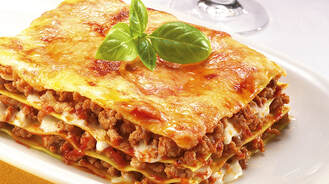 Fat Tuesday is called Mardi Gras in French but in Italy it's known as Martedì Grasso. Ash Wednesday--the beginning of Lent and fasting until Pasqua--happens the day before Martedì Grasso, which gives Italians a reason to feast and party. During Lent, Catholics are expected to give up something they love as penance. When I was a boy, the rules were very loose--giving up something you didn't like anyway was a way around the rules. But Italy is a Catholic state and many still observe full sacrifice. While some might replace meat only on Fridays with fish, others give up meat entirely during Lent. (More modern twists are giving up texting, Facebook or TV). Broken down from the Latin, Canem Levare (meat lift), the festive celebration of Carnevale can literally be thought of as a time when meat is lifted away from meals--as a sacrifice. Carnevale in Italy starts on Giovedí Grasso, the Thursday before Fat Tuesday. During this time Italy celebrates Carnevale in towns like Venice, Viareggio and the Emilia-Romagna town of Cento. But Carnevale is widespread in Italy, just as Lent is... so just before giving up meat, they feast on it... In Southern Italy, especially around Naples, the end of Carnevale is celebrated by eating Lasagne di Carnevale, a rich lasagna layered with a choice of meats, typically polpette (meatballs), sausage or a meat ragu. If you know how to make a lasagna (here's our Eggplant Lasagna recipe), then you know the basics of making a Lasagna Carnevale. Just layer in small meatballs or cut up large ones in small pieces or slices. You can also include slices of sweet or spicy sausage or a thick meat sauce (like our Bolognese recipe). Guess what we are eating tonight? --Jerry Finzi In the small Sardinian town of Nuoro, there are a very few women (you might count them on one hand) who still know how to make what many say is the rarest type of pasta in Sardinia Italy and perhaps the whole world... Su filindeu (in Sardinian dialect), and in Italian, Fili di Dio, can be translated as either Wires, Yarns or Threads of God. You might think of this pasta as the elevated and rarer version of angel hair pasta. Filindeu is tied to a religious ritual celebrated in the region of Nuoro in the town of Lula. La Festa di San Francesco is held on May 1st at the Chiesa della Solitudine di Nuoro. Oddly, this celebration is tied to a murder in the year 800 AD. Accused of murder and being hunted down for his crime, a young man claimed innocence and took refuge in a cave about 15 miles from Nuoro. He was discovered, brought to trial and miraculously (to him) declared innocent. He had prayed to Saint Francis during his time of refuge in the cave and thus built a shrine in the cave in honor of his patron saint. In autumn on October 4th, there is a second procession to the cave and shrine followed by a celebratory feast of filindeu. The dough to make this special pasta is durum semolina, water and a bit of salt, without leavening. It is then kneaded for a very long time to stretch the gluten, making it very soft with amazing elasticity--the key to making the long strands. The dough is rolled by hand into 8 long, thin snakes, which are folded, halved and pulled, only to be folded and stretched again--32 times in total--resulting in 256 thread-like thin bundles of parallel groups of pasta. These threads are then stretched across a large, flat tray called a fundu, traditionally woven from leaves of the local asphodel plant (a member of the lily family), often used in basket-making. To aide in the stretching, the dough is occasionally dipped in salt water--the timing of this sensed only by the experience of the artisan making the pasta. This process is repeated until a single layer of "threads" cover the entire fundu. the basket is then rotated by about 60° with another layers of pasta "threads" laid down. This is repeated a third time creating three crisscrossed layers of "threads". The tray is placed in the sun to dry causing the three layers to stick together while creating a stiff fabric of pasta looking very much like a course textured cheesecloth. For the feast, the filindeu is broken into pieces and put in boiling mutton broth. Grated pecorino (sheep) cheese is added to complete the soup. I don't know about you, but I've always loved my soup loaded with noodles--perfect for when the cold weather hits. If you're ever in Sardinia, look for packages of filindeu shards. Some have realized that this is a real Sardinian treasure and are trying to expand the availability of this pasta. Sadly, this unique pasta technique is in danger of becoming extinct. For example, Only one of Paula Abraini’s two daughters knows basic technique but seem uninterested in continuing the tradition. Abraini also has no granddaughters to pass he skills along to. The two other women in Abraini’s family who still carry on the tradition are both in their 50s and also have no successors to this tradition. Paula Abriani was so concerned about the techniques of making su filindeu disappearing, that she went to the local government to see if there was some money to open a school. There wasn't. Then she tried to teach young locals to make it in her home--they got discouraged with its complexity and gave up. Luckily, she was invited to Rome by the gourmet magazine Gambero Rosso so they could film her techniques for posterity. She has also started making filindeu for several restaurants who serve her amazing pasta to clients from around the world. The preservation of her tradition is looking a bit brighter! If you're traveling to Nuoro, search out the women who still make this pasta for a lesson on how it's done. They have learned the skill from their mothers who learned it from their mothers and so on, going back three hundred years. Ask, plead or beg for a lesson from either Paola Abraini, Salvatora Pisano or Grazia Selis. If you're lucky enough to get a little lesson from them, don't forget to say "thank you" in Sarda, the Sardinian dialect... grazie meda! And give them a solemn promise that you will pass along their skills. --Jerry Finzi You might also be interested in...
How to Cook Pasta: 101 Map of Regional Pasta Everything You Ever Wanted to Know about Pasta Sexy Pasta Shapes! The LIGHT Way to Make Potato Gnocchi Canederli: The Italian Matzo Ball Does Adding Water to a Pasta Sauce Make a Difference? Making Fresh Pasta: A Family Tradition Test Driving the Kitchenaid Pasta Extruder Spaghetti the Grows on Trees? Growing up, one of my favorite things to ask for when my family went to a restaurant was "meat sauce". Meat sauce on spaghetti. Meat sauce on ravioli. Meat sauce on veal cutlets. I'd even ask for meat sauce on top of chicken parmesan! Well, I've grown up and matured (OK, somewhat). In this article I'll show you how to make a grown-up version of "meat sauce"--Ragù alla Bolognese. One of the very first meals we had during our Voyage to Italy was Pici al Ragù... a Tuscan version of Spaghetti Bolognese. We had just gotten off the train from Rome in the small Tuscan town of Chiusi Scalo ("Scalo" designates the part of a town that surrounds a railway station). Chiusi proper, an historic Tuscan town with proud roots back to the Etruscans, was up on the nearby hilltop. We were so weary from having traveled about 16 hours or more, first by air to Rome and then by train from Rome to Chiusi, where we were to pick up our rental car. And at this point we were also famished--needing to re-fuel. When we got off the train, the Hertz office was closed for riposa (a 3 hour siesta), so we had planned to have lunch while we waited. I had already picked out the trattoria that we would eat at, selected weeks before while fine-tuning the details on my Google Earth maps... we would eat our first Italian meal at Trattoria Porsenna, one block from the train station. It was a fantastic choice. With only 12 tables and a casual country style, we order a bottle of gassata for the table and waited for our meals. When the Pici al Ragù came, I couldn't believe how delicious it was. By the way... Pici is a sort of thick, hand rolled spaghetti. Ragù is basically a meat sauce, the best of which is Ragù alla Bolognese, which originated in Bologna but is found all over Italy nowadays. People will tell you that "spaghetti Bolognese" doesn't exist in Italy--but it does. The sauce will just be called "Ragù" instead of "Bolognese", as in "Spaghetti al Ragù", and typically in place of spaghetti the dish is usually served with tagliatelle, a long, flat, fresh pasta noodle--"Tagliatelle al Ragù". Historic records even prove that in centuries past, spaghetti (dried) was commonly used with a Ragù sauce anyway. (NOTE: In the weeks that followed, we saw "Spaghetti alla Bolognese" listed on many menus). So, whatever the name, and no matter what type of pasta you put under it, I knew that this was the Ragù I wanted to duplicate when I returned back home. Ingredients 2 pounds ground beef (80% or less fat) 1/4 pound speck (cut 1/4" thick), 1/4" dice (Speck is a smoked prosciutto) 1 large Vidalia onion (or 2 large yellow onions) 1 teaspoon sugar (for sauteing onions) 4 tablespoons canola oil (for sauteing) 3 carrots, 1/4" dice 3 celery stalks, 1/4" dice 4 garlic cloves, smashed then diced 5 bay leaves (remove after cooking) 1-1/2 tablespoons thyme 1/4 teaspoon dried red pepper flakes 1-tablespoon dried basil 1 cup full bodied red wine (Primativo, Montepulciano, Chianti, etc.) 1-28 ounce can Tuttorosso crushed tomatoes 1-6 ounce can tomato paste 1 cup heavy cream Directions
This recipe will make enough Bolognese sauce for several meals. It also freezes very well. If you would like to make fresh tagliatelle to go with your Bolognese sauce, read Making Fresh Pasta at Home: Not a Necessity, but a Tradition. Or, try making our Torta Rigatoni Piede Bolognese al Forno - Baked Standing Rigatoni Pie with Bolognese. Or, try Baked Standing Rigatoni in a Mug. It's also wonderful spread on a bruschetta for a small lunch or snack. Buon appetito! --Jerry Finzi |
Archives
May 2024
Categories
All
|

